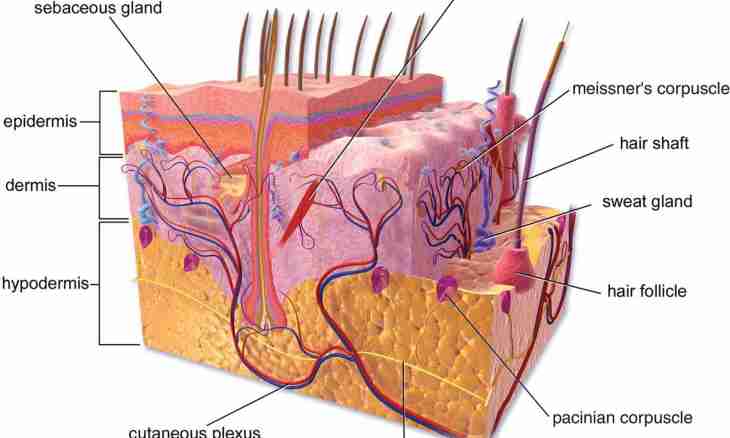Functions of skin are diverse. It protects an organism from pathogenic microorganisms, hazardous substances, ultra-violet radiation. In skin numerous receptors thanks to which she acts as an organ of touch are located. One more important function of skin – allocation.
The total area of skin of the adult varies from one and a half to 2.3 square meters. Any body does not possess such huge surface, and all this space adjoins to the external environment. It would be surprising if the nature did not use this opportunity for removal from an organism of the products of a metabolism harmful to it.
Secretory function of skin is provided stalemate also by the sebaceous glands located in it.
Human skin contains more than 2.5 million sweat glands having the form of not branching tubules. Their distribution on the surface of a body unevenly – the greatest number is concentrated on a forehead, soles and palms, and a palm differ in the greatest density of their arrangement. At the same time there are such parts of a body where there are no sweat glands at all - it is lips at all people, a head of a penis and extreme flesh, including its internal leaf, at men, and women have a clitoris and also the internal surface of big and small vulvar lips. If it was possible to collect and weigh all sweat glands of one person, on weight they would be equal to one his kidney.
Each sweat gland consists of the sekretorny ball and an output channel which is coming to an end with a time on the surface of skin. Sekretorny balls are located in a term – a soyedinitelnotkanny layer of skin, and on palms – in hypodermic and fat cellulose. Sweat glands are subdivided into ekkrinny (small) and apokrinny (big). Ekkrinnye are almost everywhere, apokrinny – in skin of axillary hollows, a pubis, lower part of a stomach, a scrotum, around back pass, in the auras surrounding nipples. At women apokrinny glands are developed more than at men, and their volume changes during a menstrual cycle. During the day sweat glands of skin excrete from 300 ml to 1 l of sweat. It is much less than amount of urine which is marked out by kidneys, and still a third of all water removed from an organism leaves through skin, and by amount of the removed calcium the sweat glands advance kidneys. With uric acid, urea, amylase, a pepsinogen, alkaline phosphatase, lipids, potassium, sodium, chlorides of different substances, minerals, organic matter and even heavy metals is removed then. At diseases of kidneys the content in sweat of the substances which are usually removed with urine increases – the organism compensates a renal failure at the expense of the strengthened work of sweat glands. Sebaceous glands play a smaller role in secretory function of skin, than stalemate, per day they excrete no more than 20 g of a secret. And still some substances are removed from an organism by means of sebaceous glands: products of disintegration of corticosteroids, sex hormones, enzymes, vitamins and also cholesterol.

